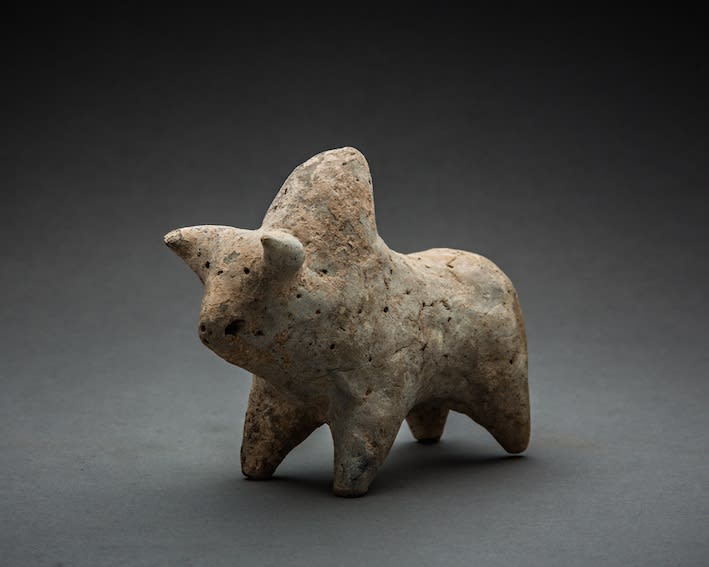Syrio-Hittite Terracotta Sculpture of a Zebu Bull, 2500 BCE - 1500 BCE
Terracotta
14.2 x 11.4 cm
5 5/8 x 4 1/2 in
5 5/8 x 4 1/2 in
X.0691
Further images
The Hittite Empire emerged in central Anatolia from fairly humble agricultural beginnings in the 2nd millennium BC, but by 1340 BC had become the dominant power in Mesopotamia. The expansion...
The Hittite Empire emerged in central Anatolia from fairly humble agricultural beginnings in the 2nd millennium BC, but by 1340 BC had become the dominant power in Mesopotamia. The expansion and consolidation of the empire saw its greatest expression under Kin Suppiluliumas I (c. 1380 -c. 1346 BC), who oversaw the establishment of a firm Hittite foothold in Syria. This was hotly contested territory, and while the Egyptian behemoth had swept aside most competition, they met extremely fierce opposition from the Hittites. This struggle for domination over Syri continued into the reign of Muwatallis (c. 1320-1294 B.C.), culminating in the famous battle of Kadesh in 1299 BC. Although Ramses II claimed a great victory, the result was in fact probably more ambiguous. The Egyptians were at a disadvantage in terms or provisioning, and in terms of the great arms race of the time over a great new invention: iron. In any case, the Egyptians took considerable pains t placate local groups, setting up socioeconomic and matrimonial alliances with the Hittites and the lands they now occupied. Although we know comparatively little about Hittite civilisation, it is perhaps significant that these shadowy populations were such a fierce threat to what was then the world's greatest civilization that even Ramses the Great found it mor beneficial to be their ally rather than their foe.
The Zebu is a species of ox with a prominent hump that had been domesticated in Eurasia since the Neolithic Period. It has assumed enormous socioeconomic significance to numerous cultures, supplying milk, labour, leather and secondary products. In the Mediterranean world, the bull was endowed with numerous virtues that led to a near cultic devotion often referred to as Tauromaquia, In the Neolithic temples of Catal Huyuk, for example, the bull was worshipped as a deity, their skulls incorporated into the architecture as sacred objects. In Greece, the bull regularly entered mythology (i.e. the legend of the Minotaur) and also seems to have played a role in precursor of modern bullfighting whereby daring gymnasts attempted to vault over the creatures usin only their horns for purchase. Versions of thes antics live on in the Camargue, and all across Spain.
This charming terracotta figure was probably a votiv offering, accompanying more perishable produce as gift to win the favour of the gods. It is beautifull executed, being a mixture of figurative and abstrac elements that convey the power and presence of th animal without recourse to overdetailing. Whil state-level organisation and wealth may hav permitted the sacrifice of a live bull, this mor modest version no doubt served the same purpose for household of more straitened means. The impact of th artistry is not diminished, however: the virility an sculptural/aesthetic power of this piece is extremel potent even today. We can only hope that the sacrific its deposition entailed brought about the require benediction.
The Zebu is a species of ox with a prominent hump that had been domesticated in Eurasia since the Neolithic Period. It has assumed enormous socioeconomic significance to numerous cultures, supplying milk, labour, leather and secondary products. In the Mediterranean world, the bull was endowed with numerous virtues that led to a near cultic devotion often referred to as Tauromaquia, In the Neolithic temples of Catal Huyuk, for example, the bull was worshipped as a deity, their skulls incorporated into the architecture as sacred objects. In Greece, the bull regularly entered mythology (i.e. the legend of the Minotaur) and also seems to have played a role in precursor of modern bullfighting whereby daring gymnasts attempted to vault over the creatures usin only their horns for purchase. Versions of thes antics live on in the Camargue, and all across Spain.
This charming terracotta figure was probably a votiv offering, accompanying more perishable produce as gift to win the favour of the gods. It is beautifull executed, being a mixture of figurative and abstrac elements that convey the power and presence of th animal without recourse to overdetailing. Whil state-level organisation and wealth may hav permitted the sacrifice of a live bull, this mor modest version no doubt served the same purpose for household of more straitened means. The impact of th artistry is not diminished, however: the virility an sculptural/aesthetic power of this piece is extremel potent even today. We can only hope that the sacrific its deposition entailed brought about the require benediction.







